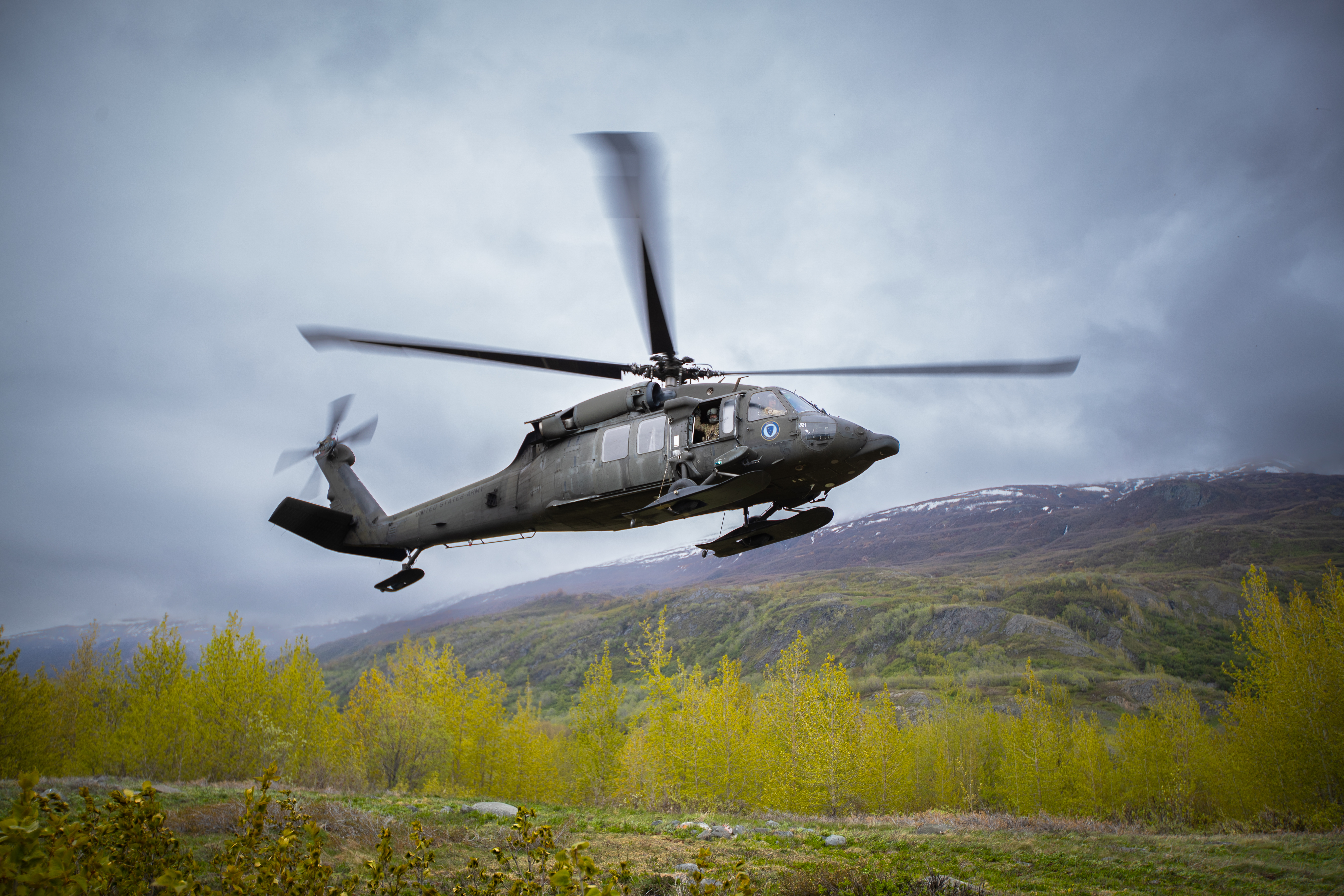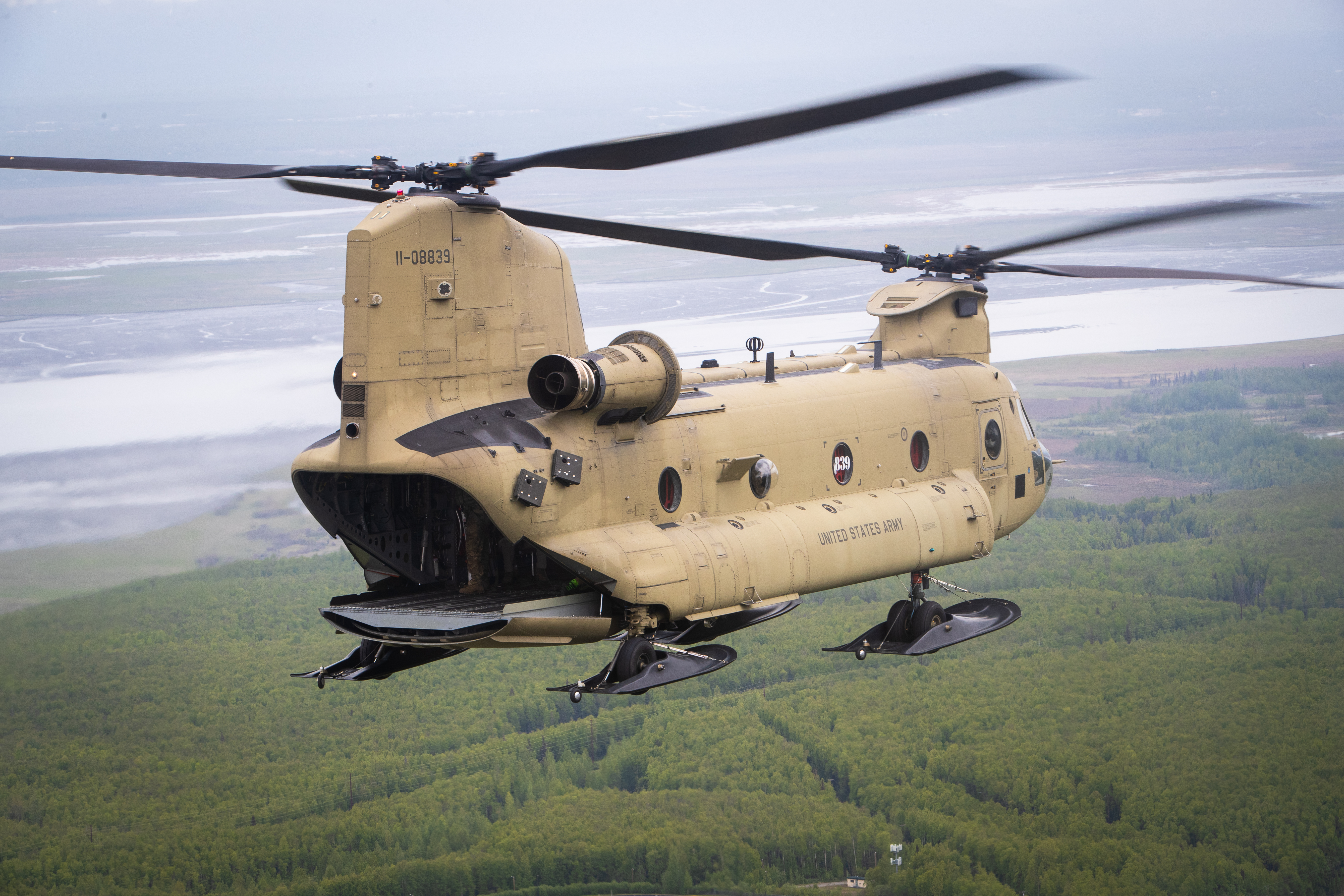Joint Base Elmendorf-Richardson — Aviation tactics instructors with Fort Novosel, Ala., U.S. Army Aviation Center of Excellence (USAACE) 110th Brigade and guardsmen with the Alaska Army National Guard 2-211th General Support Aviation Battalion recently joined together on an Army Aviation initiative to transform the USAACE Instructor Pilot Course (IPC) into an Aviation Tactics Instructor Course (ATIC).
According to Chief Warrant Officer 5 Dave Currier, Fort Novosel’s Tactics Chief with the 110th Aviation Brigade, part of the USAACE Commanding General tactics initiative in aviation is revamping the existing IPC to the newly envisioned ATIC.
Currier’s team is responsible for overseeing the process. The end state: to create a five-phased course encompassing in-depth mission planning, single and multi-ship operations, with a strong focus on tactics, to include air-to-air tactical maneuvers.
 An Alaska Army National Guard UH-60L Black Hawk helicopter from Golf Co., 2-211th General Support Aviation Battalion hovers during a training mission May 31, 2023. Guardsmen with the Alaska Army National Guard and Aviation tactics instructors with Fort Novosel, Ala., U.S. Army Aviation Center of Excellence 110th Brigade worked on an aviation initiative to transform the USAACE Instructor Pilot Course into an Aviation Tactics Instructor Course. (Alaska National Guard photo by Robert DeBerry)
An Alaska Army National Guard UH-60L Black Hawk helicopter from Golf Co., 2-211th General Support Aviation Battalion hovers during a training mission May 31, 2023. Guardsmen with the Alaska Army National Guard and Aviation tactics instructors with Fort Novosel, Ala., U.S. Army Aviation Center of Excellence 110th Brigade worked on an aviation initiative to transform the USAACE Instructor Pilot Course into an Aviation Tactics Instructor Course. (Alaska National Guard photo by Robert DeBerry)“The previous training was more focused on basic airmanship, traffic patterns, how to fly a helicopter, how to do instruments etc.,” said Currier. “We are now changing it to focus more on the war fighting functions of aviation. We are bringing Army tactical aviation into the course and teaching how to be instructors on tactics verses how to be instructors in just a helicopter.”
Chief Warrant Officer 2, Bradley Jorgensen, Aviation Mission Survivability Officer with the Alaska Army National Guard Golf Company, 2-211th, General Support Aviation Battalion, said he sees this as a tactical shift in operations.
“For the last 20 years, we have operated in a certain type of environment, and we are now pulling out of that environment, pulling out of those areas of operation and so we have to adapt to new threats on the battlefield that we have not had to face,” said Jorgensen.
As the Army shifts to a peer-to-peer concept in a large-scale fighting force, there is a generation of pilots that have been operating based on the coined term ‘desert environment.’ The transition to tactical-based training involves getting back to principles that have long been part of doctrine.

With that tactical shift comes the need for a bridging solution for pilots trained through the IPC, so they can get trained up on new tactics and adjust to the new Army aviation training model.
Currier said the training in Alaska serves as a great proof of concept for skills embedded in the new course.
“I can’t go out there with legacy instructor pilots in the course and tell them I want to teach them something new. Because it is not in accordance with the course management plan yet,” said Currier. “So, in order for me to validate the new course management plan we have to test it.”
USAACE and National Guard Bureau have hosted other train-the-trainer events, and these venues have been great opportunities to update the force with other changes within Army aviation. Currier said he has worked with the Alaska National Guard before and knew there was interest.
“It was a request by the unit to come out and provide a little more knowledge on what we are trying to do down there and provide some academics and some flight training for some of the tactics we are starting to teach at Fort Novosel,” he said.
“Working with these guys is great because there is that real-time feedback from an operational force. We can hear what is of value or what is not of value,” he said. “These guys really become an integral part of the curriculum development, because from their feedback, we can tailor our course management plan as we develop our course.”

An Alaska Army National Guard UH-60L Black Hawk helicopter from Golf Co., 2-211th General Support Aviation Battalion maneuvers past the Knik Glacier during a training mission May 31, 2023. (Alaska National Guard photo by Robert DeBerry)
Jorgensen is hoping the tactics training will be a reoccurring event and possibly branch out to guard units across multiple states.
“Hopefully we grow what we did this week. Take the lessons learned from that, incorporate more flying and bring in some of our other state partners,” he said.
The five-day tactics training consisted of three days of academics and two days of flying.
Currier said the culminating event is designed to teach the aviators how to develop a tactical scenario at home station that is relevant in a large-scale combat operation against a near-peer threat.
Jorgensen pointed out that the guard needs to be mindful not to get too stagnant.
“We are really good in our areas of operation but sometimes we get passed up a little bit with new things coming down” he said. “This is a way for us to stay relevant and fresh.”
Learning how to integrate the concepts into the day-to-day flying will bring a stronger focus on tactical flight verses the general aviation support the guard does every day, he said.
“We have the aircraft, we have the talented pilots, we have the talented crew chiefs that can do it,” said Jorgensen. “It is just bringing it to the forefront on how we can implement that into our day-to-day operations.”
Jorgensen said an example of a greater focus on tactical training would be to look at how flight planning and routes are discussed.
“Instead of going direct to Bethel, let’s think about this tactically, and how would we do it if we had multiple threats enroute,” he said.
Currier said this was a good example of tactical training without needing tactical gear. He said depending on where they are stationed, Army aircraft are equipped differently, and most will not have a go-to-war configuration.
“You can still train this stuff in your own backyard to your junior guys,” he said. That is the design. They can still do Army tactics.”
Jorgensen agrees and says it’s a matter of taking those ideas and concepts from the team and knowing how to implement them without making huge changes. He said he is already seeing teams planning differently and looking at the general aviation flights with a more tactical focus.
Currier said the Alaska tactics training has been a two-way street. He said his team has been able to listen to feedback which will allow them to improve their instruction, strengthen the course management plan and method of instruction while sharing relevant tactics with the Guard.